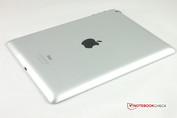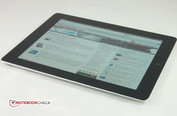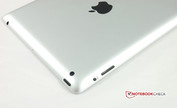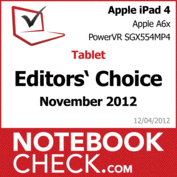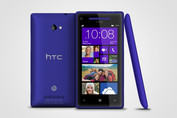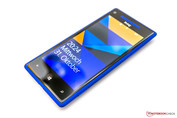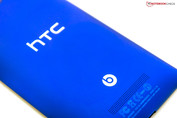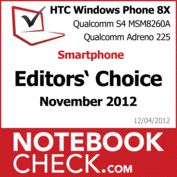Notebookcheck's Best of November 2012 – Smartphone and Tablet Edition
For the original German article, see here.
While October was still fairly placid in terms of tablets and smartphones, a torrent flooded the market in November. We were also occasionally swamped in our test labs, which was primarily due to the long-awaited innovations from Microsoft and Apple. Concurrent to the launch of Windows 8, Microsoft introduced its "first PC" as the Redmonders dubbed their Surface tablet in its online shop. However, the promised short delivery times could not be kept and so our Surface RT test device featuring a Touch Cover arrived a bit later. In return, we could send the equally new iPad Mini and iPad 4 tablets from Apple over our test course on their first sales day.
The likely largest online retailer, Amazon, also recently updated its Kindle range. Of course we tested the Kindle Fire HD 7 right away, just like other tablet innovations like the affordable Prestigio MultiPad 7.0 Prime Duo or the high-res Huawei 10 FHD.
November brought us three smartphones for review. Among them, two very exciting novelties: The first Windows 8 Phone at notebookcheck.com is called HTC 8X. Motorola's RAZR i is also a world's first – as the first smartphone featuring Intel's Atom processor. Samsung contributes another midrange smartphone with a dual-SIM function dubbed Galaxy S DUOS to the lineup.
Category: Tablets
Contenders:
Apple iPad 4: 91 %
Apple iPad Mini: 89 %
Lenovo IdeaTab S2110A: 84 %
Amazon Kindle Fire HD 7: 85 %
Trekstor Surftab Ventos: 9.7 82 %
Microsoft Surface RT: 88 %
Prestigio MultiPad 7.0 Prime Duo (PMP5770D): 86 %
Huawei MediaPad 10 FHD: 85 %
Apple's iPad 4 was our first tablet in November. The American manufacturer virtually made no modifications compared with the predecessor. Merely the previous docking port had to make way for the new Lightning Connector. It is smaller and can be used in "both directions". Nothing has changed about the high-res screen Apple calls Retina. It still belongs to the best on the market, which also applies to choice of materials and workmanship. Apple managed to surprise us anyway: The high performance of the new A6x chip excels all other tablets – at least at present. Nevertheless, there are also points of complaint. The memory cannot be expanded, it is not exactly a lightweight and LTE or 3G is only available for a steep surcharge. The bottom line was 91 percent for Apple's iPad 4.
We reviewed the iPad Mini at the same time as the iPad 4. What did Steve Jobs say about 7-inch tablets once? "It is meaningless, unless your tablet also includes sandpaper, so that the user can sand down their fingers to around one-quarter of the present size." Nevertheless, Apple now also has a small tablet in its range. It is technically based on the iPad 2 and is thus no longer quite up-to-date in terms of performance. Despite that, our tester verified the device to have a good everyday performance. The XGA resolution is also only middling nowadays. However, we were still satisfied because of its small screen surface. The iPad Mini also scored with its great workmanship, low weight and long battery life. We also had to criticize the missing memory expandability, the additional high price for LTE/3G and the casing's susceptibility for fingerprints. We rated it with 89 percent.
One of the to-date thinnest and lightest 10-inch tablets is Lenovo's IdeaTab S2110A. Despite a dual-core SoC and incorporated keyboard, it lures with a price of below 400 Euros (~$523). The Android tablet weighs just 570 grams (~1.26 pounds) and has a height of a mere 8.7 millimeters (~0.34 inches). The IdeaTab S2110A earns praise for its bright IPS screen and great looks. Moreover, we found the long battery life and the consequent high mobility compelling. In return, the only average build and not quite state-of-the-art UI performance did not appeal to us as much. Also, the internal 16 GB memory can only be expanded via a card reader integrated into the dock. Thus, the final rating was 84 percent.
Only a touch better, namely 85 percent, was reached by Amazon's Kindle Fire HD 7. Its price of 199 (~$260) is almost unmatched compared with other Android 4 tablets. However, it has to compete against Google's Nexus 7, where the Amazon tablet displayed both assets and drawbacks. The Kindle's handling is easy, but the largely Amazon-based content confines the user. There is also no official support for Android apps. Then again, the screen is very bright and even allows using it outdoors in the sun. We criticized the lack of memory expandability and non-existing 3G option. The performance was also only average.
TrekStore's SurfTab Ventos 9.7 was also at the tablet starting line. It wants to score with its money for value ratio. It costs 250 (~$327) and brings along very decent equipment. The workmanship is also of a high standard throughout. Aluminum unibodies and the IPS screen are not a matter of course in this price range. It exhibited good contrasts and stable viewing angles, but we reproached its brightness. That was unfortunately continued in the touchpad's accuracy. It simply doesn't always do what it should. Many buyers will miss the certification for Google's Play Store and thus access to tens of thousands of apps. However, it should be possible to bypass this restriction with a bit of research. The battery life is top and the performance also fits.
Besides Apple's iPads, Microsoft's Surface RT is the highlight in the tablet month of November. Eagerly awaited, it finally arrived in our test lab and convinced us in many areas right away. The use of Windows 8 RT is exemplary. The iOS and Android contenders could definitely take it as an example. Moreover, the workmanship is on a very high standard, and we especially liked the integrated support called kickstand. The screen is very bright, but the HD resolution doesn't quite fulfill the premium claim. That was also true for the benchmark scores. The performance is certainly not uncompromising. Nevertheless, restrictions will not be noticed in routine use. The touch cover adds a real added value. All in all, a great tablet.
It can't get less expensive than the Prestigio MultiPad 7.0 Prime Duo (PMP5770D). 150 (~$196) for a full-fledged 7-inch tablet featuring Android Ice Cream Sandwich and access to Google's Play Store can't be topped. If you now fear that too many cutbacks have been made, you are wrong. The MultiPad 7.0 Prime does not belong to the fastest of its kind, but the performance is absolutely suitable for everyday use. A good build quality, a very good screen and decent equipment can be added to that. The short battery life and partly very high temperature mar the pleasure a bit.
Last but not least, Huawei's MediaPad 10 FHD faced our tests. As the name hints, the 10-incher features a Full HD capable screen, which is not a matter of course at a price of below 500 (~$653). That is also true for the high-quality build and the long battery life. In return, Huawei made cutbacks in the small 8 GB internal memory. A 3G model is not available even for a surcharge. Huawei's tablet messed up in performance. Only a few modern games run smoothly in low detail settings. This should not be the case for a modern quad-core tablet.
Tablet of November 2012: Apple iPad 4
It was ultimately a battle of three for the tablet crown in November 2012. In the finals: Apple's iPad 4, Microsoft's Surface RT and Prestigio's MultiPad 7.0 Prime Duo (PMP5770D). Since Apple's iPad 4 is much stronger than Microsoft's tablet and the price is not a part of our rating, the first place goes to Cupertino.
What we like
The good performance and the front camera, which now offers better image quality for video chats.
What we miss
A slimmer and lighter case. In addition, the screen should be brighter.
What surprises us
Apple has once again left the competition behind in the dust; this time, it is all thanks to the A6X chip. But, have no doubt, the competition will catch up.
The competition
The iPad 4 has to hold its own against high-end models. These include the Samsung Galaxy Note 10.1 and the Asus Transformer Pad Infinity TF700T. The iPad 3 will also be a fierce competitor.
Category: Smartphones
Contenders:
Samsung Galaxy S DUOS GT-S7562: 84 %
HTC Windows Phone 8X: 86 %
Motorola RAZR i: 86 %
Three smartphones came in for review in November. All candidates are something special, but first things first.
Samsung's Galaxy S DUOS belongs to the rare species of smartphones with dual-SIM card support. However, the Korean manufacturer only uses a midrange phone for this handy feature. The use of a single-core processor and a very small internal memory underlines this classification. We did not have any complaints on workmanship or the screen’s brightness and stable viewing angles. However, the fact that the Galaxy S DUOS does not play HD contents limits everyday use, just like the camera's middling quality. In return, the dual-SIM functionality compensates for that.
The very first Windows Phone 8 reached our offices in the form of HTC's Windows Phone 8X. And we were fascinated by the new arrival right away – especially from the innovative usage via the Windows 8 interface dubbed "Modem UI". The Windows store is not yet overflowing with apps. However, that will likely change fast. HTC's 8X also earned praise for its perfect workmanship, modern and colorful design, bright screen and useful rear-facing camera. We can't explain why HTC omitted a micro SD slot though. Although it cannot quite keep up with the premium models of the iOS and Android contenders, it does a good job. All in all a decent start.
Another innovation came to us in the form of Motorola's RAZR i. It is the first smartphone that is equipped with an Intel CPU. The Atom processors achieved fame because they virtually introduced the netbook era. The CPU only sports one core, but it has a high clock rate and is capable of Hyperthreading, which is also an innovation in the smartphone category. The SoC's performance is very appealing, but there are still compatibility problems so that some apps either don't start or crash suddenly. The casing makes a very robust impression, although it is not wafer-thin. We noticed the screen and the battery life favorably. In return, we criticized the non-removable battery, lack of color options and the relatively low resolution.
Smartphone of November 2012: HTC Windows Phone 8X
And the winner is… HTC's Windows Phone 8X. It simply exhibits the most complete package. Although it achieves the same rating as Motorola's RAZR i, it doesn't have as many shortcomings and, due to its great usability, it strides on the road to victory. As to the RAZR I, we have to say the second is not the last place.
What we like
The good workmanship and solid hardware and software performance in all areas.
What we'd like to see
The application variety like for Android and iOS.
What surprises us
Innovative operating concept with an appealing metro design.
The competition
HTC's 8X finds competitors in Nokia's Lumia 920 and Samsung's Ativ S. Both are also high-end devices that are all vying for the Windows Phone 8 crown. The main competitors for the new operating system are indisputably Google's Android and Apple's iOS.


 Deutsch
Deutsch English
English Español
Español Français
Français Italiano
Italiano Nederlands
Nederlands Polski
Polski Português
Português Русский
Русский Türkçe
Türkçe Svenska
Svenska Chinese
Chinese Magyar
Magyar